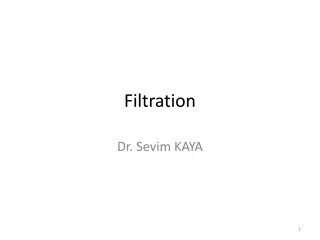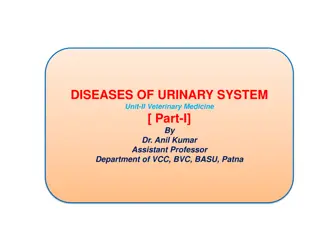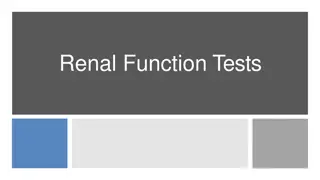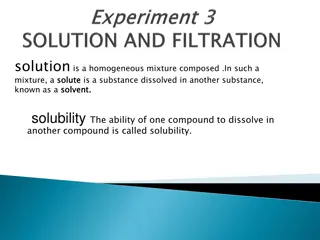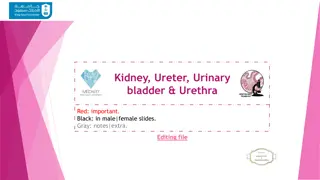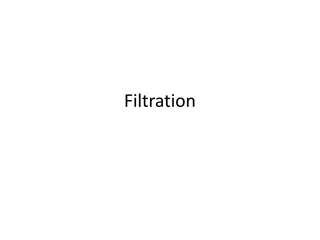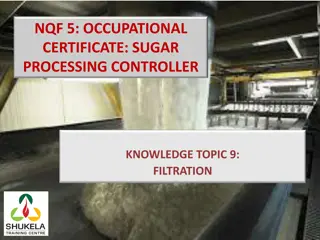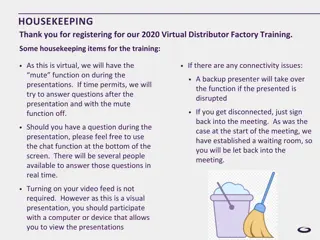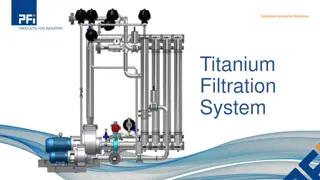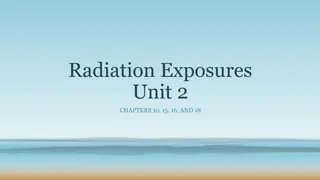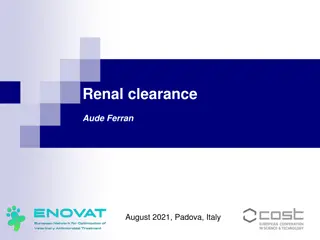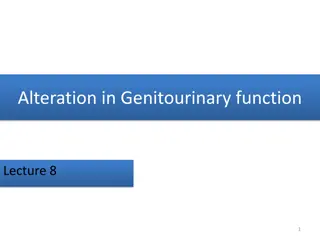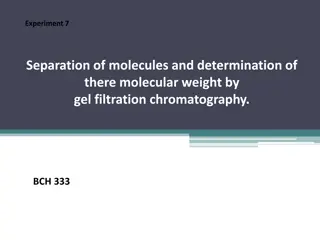Regulation of Glomerular Filtration and GFR Physiology Overview
This detailed study delves into the regulation of glomerular filtration rate (GFR) in the kidneys. It covers the intrinsic and extrinsic mechanisms that control GFR, autoregulation, tubuloglomerular feedback, glomerular filtration membrane, filtration forces, molecular size and filterability of substances, and physiological factors impacting GFR. Additionally, it explores the control of GFR through various pressures and factors affecting renal blood flow. Understanding these concepts is crucial for comprehending the intricacies of kidney function.
Download Presentation

Please find below an Image/Link to download the presentation.
The content on the website is provided AS IS for your information and personal use only. It may not be sold, licensed, or shared on other websites without obtaining consent from the author.If you encounter any issues during the download, it is possible that the publisher has removed the file from their server.
You are allowed to download the files provided on this website for personal or commercial use, subject to the condition that they are used lawfully. All files are the property of their respective owners.
The content on the website is provided AS IS for your information and personal use only. It may not be sold, licensed, or shared on other websites without obtaining consent from the author.
E N D
Presentation Transcript
L2 Regulation of Glomerular Filtration Physiology renal Editing File - Color Index: Main Text Male s Slides Female s Slides Important Doctor s Notes Extra Info
Objectives Describe Intrinsic and extrinsic mechanism that regulate GFR. Describe autoregulation of GFR & tubuloglomerular feedback mechanism. Explain glomerular filtration membrane & filtration forces. In both l1 and l2 but it s explained better in l1
1 GFR (Glomerular Filtration Rate) Defined as: The volume of filtrate produced by both kidneys per min Averages 125 ml/min Totals about 180L/day (45 gallons) So most filtered water must be reabsorbed or death would ensue from water lost through urination GFR= 125 ML/MIN OR 125X60X24=180000=180 L/DAY Normal Urinary Output = 1.5 L/day Daily Reabsorption 180-1.5=178.5 L/day Percent Reabsorbed =178.5/180x100=99.2% Percent Excreted = 100-99.2=0.8% (Less than 1 % becomes urine) 20% of the cardiac output (5 L) goes to the kidneys. So 20% of 5 Liters is 1000 ml of blood. Blood composed of plasma and cells . And because cells don t get filtered due to they are large in size. So 1000 ml of blood composed of 400 ml are cells, and 600 ml is plasma. 1)600 ml of Plasma will go to the kidneys. 2)Only 20% will get filtered (Note that 600 ml x 20% = 120-125 ml/min, which is the GFR). 3)19% will get reabsorbed . 4. 1% will be excreted in urine.
2 MOLECULAR WEIGHT MOLECULAR SIZE nm SUBSTANCE FILTERABILITY Water 18 0,15 1.0 Sodium 23 0,1 1.0 Glucose 180 0,33 1.0 Inulin 5,500 1.48 1.0 Myoglobin 17,000 1.88 0.75 Albumin (6 nm) 69,000 3.55 0.005 Filterability of Solutes Is Inversely Related to Their Size Negatively Charged Large Molecules Are Filtered Less Easily Than Positively Charged Molecules of Equal Molecular Size. Dextrans are polysaccharides that can be manufactured as neutral molecules or with negative or positive charges. IgA Nephropathy is a kidney disease that occurs when an antibody called immunoglobulin A (IgA) builds up in your kidneys. This results in local inflammation that, over time, can hamper your kidneys' ability to filter waste from your blood. CONTROL OF GFR GFR = Kf x [(PG-PB)-(G- B)] OR GFR = Kf x [(60-18)-(32- 0)] (1)Hydrostatic pressure inside the glomerular capillaries (glomerular hydrostatic pressure, PG), which promotes filtration (2)The hydrostatic pressure in bowman's capsule (PB) outside the capillaries, which opposes filtration (3)The colloid osmotic pressure of the glomerular capillary plasma proteins ( g), which opposes filtration (4)The colloid osmotic pressure of the proteins in bowman's capsule ( b), which promotes filtration
3 Physiological regulation of GFR PB= GFR If the constriction is extreme it obstructs the arteriole completely leading to accumulation of blood in Glomerulus so GFR will increase first and then it would decline due to Increased in proteins (oncotic pressure). Factors that constrict the Afferent & decrease PG: Sympathetic stimulation, will decrease GFR and RBF. Epinephrine, will decrease GFR Norepinephrine, will decrease GFR and RBF Endothelin, will decrease GFR decreased VIt D Factors that constrict the Efferent: Angiotensin II, will constrict Eff more than Aff, and will decrease RBF. (prevents decrease of GFR) Other factors affecting Renal blood flow and GFR: High protein diet increases GFR. because B has increased. Hyperglycemia increases RBF and GFR. Fever increases RBF and GFR. Aging decreases RBF and GFR. Dehydration decreases RBF and GFR
4 Physiological Regulation of GFR Constriction of afferent arteriole Constriction of efferent arteriole Moderate Sever PG G PG GFR GFR GFR Sympathetic stimulation Epinephrine Norepinephrine Endothelin Angiotensin II
5 Factors That Can Decrease the GFR Physical Determinants* Physiologic/Pathophysiologic Causes Renal disease, diabetes mellitus, hypertension, aging Kf GFR Urinary tract obstruction (e.g., kidney stones) PB GFR G GFR Renal blood flow, increased plasma proteins PG GFR AP PG Arterial pressure (has small effect due to autoregulation) RE PG Angiotensin II (drugs blocking angiotensin II formation) Sympathetic activity, vasoconstrictor hormones (e.g., norepinephrine, endothelin) RA PG Kf, glomerular filtration coefficient; PB, Bowman's capsule hydrostatic pressure; G, glomerular capillary colloid osmotic pressure; PG, glomerular capillary hydrostatic pressure; AP, systemic arterial pressure; RE, efferent arteriolar resistance; RA, afferent arteriolar resistance. * Opposite changes in the determinants usually increase GFR. Increased Glomerular Capillary Filtration Coefficient (Kf) Increases GFR The Kf is a measure of the product of the Permeability and surface area of the glomerular capillaries. The Kf cannot be measured directly Increased Kf raises GFR and decreased Kf reduces GFR
6 GFR is directly proportional to the NFP -An increase in NFP GFR -A decrease in NFP GFR Changes in GFR normally result from changes in glomerular blood pressure. NFB = Net foltiration rate If the GFR is too high: Fluid flows through tubules too rapidly to be absorbed. Urine output rises Creates threat of dehydration and electrolyte depletion. If the GFR is too low: Fluid flows sluggishly through tubules. Tubules reabsorb wastes that should be eliminated. Azotemia develops (high levels of nitrogen-containing substances in the blood). Factors affecting GFR Renal blood flow (Autoregulation effect also). flow GFR flow GFR Glomerular Capillary hydrostatic pressure Hydrostatic pressure in bowman s Capsule Sympathetic Nervous system Pr GFR Pr GFR GFR GFR Hormonal & Autocoid Control Variable effect in plasma colloid osmotic pressure Changes in kf (Permeability and Surface Area) GFR Kf GFR Kf GFR Misc: High Protein Diet increase , Hyperglycemia increase , Glucocorticoids increase , Fever increase , Aging decrease , Dehydration decrease
7 FILTRATION FRACTION -Fraction of renal plasma that becomes Glomerular Filtrate. -Ff = GFR/Renal Plasma Flow = 125 ml per min/650 ml per min= 19.2 or approximately 20% -About 20 percent of the plasma flowing through the kidney is filtered through the glomerular capillaries. Why Are Large Amounts of Solutes Filtered and Then Reabsorbed by the Kidneys? It allows the kidneys to rapidly remove waste products from the body that depend primarily on glomerular filtration for their excretion. Most waste products are poorly reabsorbed by the tubules and, therefore, depend on a high GFR for EFFECTIVE REMOVAL from the body. It allows all the body fluids to be FILTERED AND PROCESSED BY THE KIDNEY MANY TIMES EACH DAY. Because the entire plasma volume is only about 3 liters, whereas the GFR is about 180 L/day, the entire plasma can be filtered and processed about 60 times each day. Net Filtration Pressure (NFP) -The net filtration pressure represents the sum of the hydrostatic and colloid osmotic forces
8 Why is it important to have the GFR regulated? Effect of Arterial BP on GFR: ABP GFR. However, the body maintains constant GFR over an ABP range of 75-160 mmHg. Why ? And how? By autoregulation, explained next slide Autoregulation largely occurs by the regulation of Renal Vascular resistance This does not happen in the body because of tubuloglomerular 70/75-160/180 mmHg feedback and glomerulotubular balance. Autoregulation of renal blood flow and glomerular filtration rate but lack of autoregulation of urine flow during changes in renal arterial pressure in blood- perfused kidneys that have been removed from the body. regulation of GFR: GFR controlled by adjusting glomerular blood pressure through the following mechanisms: Myogenic autoregulation. Autoregulation Tubulo-glomerular feedback mechanism. Sympathetic control Hormonal mechanism: renin and angiotensin
9 Autoregulation of GFR -Refer to feedback mechanisms intrinsic to the kidney that keep the renal blood flow and GFR relatively constant despite fluctuations in ABP. -These mechanisms operate over an ABP ranging between 75-160 mmHg. Achieved by 2 major mechanisms: 1. Myogenic autoregulation. 2. Tubulo-glomerular feedback mechanism. Renal Autoregulation of GFR - BP ->constrict afferent arteriole, & dilate efferent. - BP ->dilate afferent arteriole, & constrict efferent . -Stable for BP range of 75 to 160 mmHg (systolic) . -Cannot compensate for extreme BP changes Juxtaglomerular Apparatus Example of autoregulation
10 Mechanism of GFR AutoRegulation Mechanism of GFR AutoRegulation Intrinsic Extrinsic 1. SYMPATHETIC INNERVATION: -Cause arteriole vasoconstriction and reduced GFR. MYOGENIC: -Intrinsic property of mesangial (smooth muscle) cells and in afferent arteriole -Reflex contraction induced by increased blood pressure reduces filtration 1. ANGIOTENSIN II: -Produced as a result of renin release from kidney -Constricts efferent arteriole; prevent decrease in GFR 1. TUBULOGLOMERULAR FEEDBACK: -Flow rate sensed by macula densa & sends signals to alter afferent arteriole resistance. 1. NITRIC OXIDE (NO): -Causes arteriolar vasodilation. 1. Explained in next slide Arterial Pressure Glomerular Hydrostatic Pressure - - Macula densa NaCl sends 2 signals Renin Afferent Arteriolar Arteriolar resistance Angiotensin ll Efferent arteriolar resistance
11 Tubuloglomerular Feedback A feedback mechanism that links changes in sodium chloride concentration at the macula densa with the control of renal arteriolar resistance Two components that act together to control GFR: (1)An afferent arteriolar feedback mechanism (2)An efferent arteriolar feedback mechanism. In the absence of autoregulation, a relatively small increase in blood pressure (from 100 to 125 mm Hg) would cause a similar 25 per cent increase in GFR (from about 180 to 225 L/day) GFR explanation Example: Decreased ABP of high protein diet decrease in NaCl delivery The macula densa cells, which are capable of sensing this change, this will cause two effects to restore GFR: 1- Decrease in resistance of Afferent arterioles (i.e.Vasodilation) lead to increase glomerular hydrostatic pressure to normal levels. 2- increase in renin release from JG cells > Ang II >constrict Efferent arterioles leads to increase glomerular hydrostatic pressure & GFR back to normal
12 GFR Example: Increase ABP increase in NaCl delivery to DCT The macula densa is alerted GFR is restored by: Vasoconstriction of Afferent Release of adenosine GFR is back to normal renal Arteriolar Pressure glomerular capillary Pressure Tubuloe- glomerular feedback GFR Tubule-glomerular balance Solutes reabsorption in proximal tubule Solutes reabsorption in thick ascending limb Salt and fluid delivery to the distal tubule An increase in GFR causes an increase in the reabsorption of solutes, and consequently of water, primarily in the proximal tubule, so that in general the percentage of the solute reabsorbed is held constant. This process is called glomerulotubular balance , and it is particularly prominent for Na + Signals from the renal tubule in each nephron feed back to affect filtration in its glomerulus.
13 Myogenic system It is the intrinsic capability of blood vessels to constrict when blood pressure is increased. When BP is high, renal blood vessels constrict to prevent an increase in GFR by decreasing renal flow When BP is low, renal blood vessels dilate to prevent a drop in GFR by reducing arterial resistance and increasing blood flow. Hormonal Control of GFR Renin release Renin will convert Angiotensinogen to Angiotensin I Angiotensin I will be converted to Angiotensin II Angiotensin II will do many things but in the kidney will do two things: Vasoconstriction on Efferent arterioles -> decrease fluid that goes to peritubular capillary -> decrease in blood pressure -> increase reabsorption -> fluid will back to the body -> blood pressure back to normal -> GFR also back to normal -> urine will decrease
14 Sympathetic Control of GFR (Extrinsic) When the sympathetic nervous system is at rest: Renal blood vessels are maximally dilated Autoregulation mechanisms prevail (overcome) Under stress: Norepinephrine is released by the sympathetic nervous system Epinephrine is released by the adrenal medulla Afferent arterioles constrict and filtration is inhibited Note: during fight or flight blood is shunted away from kidneys *more blood to your brain and muscles The sympathetic nervous system also stimulates the renin-angiotensin mechanism *by stimulating B1 receptors in juxtaglomerular cells this induces vasoconstriction of efferent arteriole. Note: there s no parasympathetic effect on the kidney Some Conditions That Influence Renal Blood Flow (RBF) and the Glomerular Filtration Rate (GFR). High Protein Intake and Hyperglycemia Increase Renal Blood Flow and Glomerular Filtration Rate. a Refers to early effects, prior to development of glomerular injury that may occur with chronic hyperglycemia, obesity, and high salt intake.
15 Summary GFR (Glomerular Filtration Rate) Defined as: The volume of filtrate produced by both kidneys per min Averages 125 ml/min GFR is proportional to NFP Regulation of GFR Sympathetic Autoregulation Hormonal Tubuloglomerular Feedback the macula densa were sensory cells that can sense changes in ions . -GFR NaCl > vasoconstriction of affront. -GFR NaCl > vasodilation of affront. Under stress: Norepinephrine is released by the sympathetic nervous system -Epinephrine is released by the adrenal medulla - Afferent arterioles constrict and filtration is inhibited Myogenic system capability of blood vessels to constrict when blood pressure is increased. -BP high >renal blood vessel constrict . -BP low >renal blood vessel dilate.
Quiz Q1 What is the average of GFR? A. 175 ml/min B. 200 ml/min C. 125 ml/min D. 80 ml/min Q2 Which of the following is correct ? A. GFR is indirectly proportional to the NFP B. GFR is directly proportional to the NFP C. GFR is indirectly inversely proportional to the NFP D. GFR is directly inversely proportional to the NFP Q3 Which of the following factors has a variable effect? A. Hormonal control B. Autocoid control C. both A and B D. none of them Q4 Which of the following is an autoregulation of GFR ? A. Myogenic auto-regulation. B. Tubulo-glomerular feedback mechanism. C. Sympathetic control D. both A and B
Quiz Q5 Which of the following is extrinsic mechanism of GFR autoregulation A.myogenic B.Nitric oxide NO C.tubuloglomerular D. A&C Answers: 1-C , 2-B, 3-C, 4-D, 5-B SAQs Define Glomerular Filtration Rate. The volume of filtrate produced by both kidneys per min SAQs What are the factors affecting GFR? Slide 4
Members Team Leaders Razan Almohanna Raneem Alwatban Khalid Alrasheed Othman Alabdullah Team Members Saad Alahmari Lina almohsen Theme was done by Shatha Almutib physio442@gmail.com


